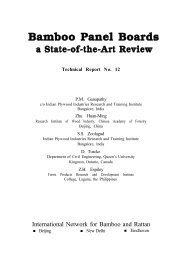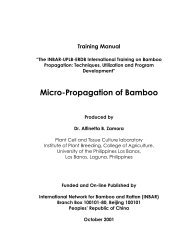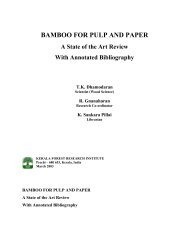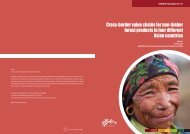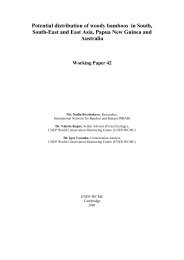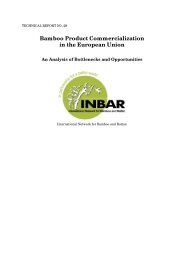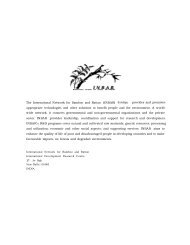The Bamboo and Rattan Sectors in Asia: an Analysis of ... - INBAR
The Bamboo and Rattan Sectors in Asia: an Analysis of ... - INBAR
The Bamboo and Rattan Sectors in Asia: an Analysis of ... - INBAR
Create successful ePaper yourself
Turn your PDF publications into a flip-book with our unique Google optimized e-Paper software.
In the second period, dur<strong>in</strong>g the b<strong>an</strong> (1979-92), there was considerable adjustment<br />
with<strong>in</strong> the <strong>in</strong>dustry. Dur<strong>in</strong>g this period, ASMINDO formed the Market<strong>in</strong>g Commission<br />
for <strong>Ratt<strong>an</strong></strong> Products to assist its members to develop ratt<strong>an</strong> products m<strong>an</strong>ufactur<strong>in</strong>g<br />
units, <strong><strong>an</strong>d</strong> to help them market their products abroad. For a number <strong>of</strong> reasons the<br />
<strong>in</strong>dustry <strong>in</strong> Java benefited most from this assist<strong>an</strong>ce. Essentially, Java had a much<br />
more adv<strong>an</strong>ced economy, with a larger pool <strong>of</strong> skilled labor, much better <strong>in</strong>frastructure<br />
(<strong>in</strong>clud<strong>in</strong>g the all-import<strong>an</strong>t tr<strong>an</strong>sportation <strong><strong>an</strong>d</strong> communications facilities) <strong><strong>an</strong>d</strong> more<br />
collective experience <strong>in</strong> deal<strong>in</strong>g with enterprise development <strong><strong>an</strong>d</strong> <strong>in</strong>ternational trade.<br />
Trade patterns ch<strong>an</strong>ged signific<strong>an</strong>tly with the rule ch<strong>an</strong>ges. Earlier the ma<strong>in</strong><br />
stakeholders were the collectors, the <strong>in</strong>termediaries, <strong><strong>an</strong>d</strong> the exporters who sold the<br />
c<strong>an</strong>e to the <strong>in</strong>ternational market. With the export b<strong>an</strong>, a new group <strong>of</strong> <strong>in</strong>ter-isl<strong><strong>an</strong>d</strong><br />
traders got <strong>in</strong>volved <strong>in</strong> the trade <strong>of</strong> raw c<strong>an</strong>e to Java. Semi-process<strong>in</strong>g enterprises<br />
beg<strong>an</strong> to build up <strong>in</strong> Sulawesi, even before the b<strong>an</strong> on <strong>in</strong>ter-isl<strong><strong>an</strong>d</strong> trade <strong>in</strong> raw c<strong>an</strong>e.<br />
<strong>The</strong>re were 42 units by 1990 <strong><strong>an</strong>d</strong> 58 units <strong>in</strong> 1995. By 1995, the local semi-process<strong>in</strong>g<br />
<strong>in</strong>dustry consumed 89% <strong>of</strong> the raw c<strong>an</strong>e produced <strong>in</strong> the state: just 8% went to West<br />
Java, <strong><strong>an</strong>d</strong> the rest to South Sulawesi, East Java <strong><strong>an</strong>d</strong> Jakarta. <strong>The</strong> bulk <strong>of</strong> the semif<strong>in</strong>ished<br />
ratt<strong>an</strong> goes to Java, primarily as tr<strong>an</strong>sfers with<strong>in</strong> vertically <strong>in</strong>tegrated firms.<br />
<strong>The</strong> four prov<strong>in</strong>ces <strong>of</strong> Sulawesi together supply 96% <strong>of</strong> the c<strong>an</strong>e used <strong>in</strong> the large East<br />
Java c<strong>an</strong>e furniture <strong>in</strong>dustry.<br />
<strong>The</strong> export b<strong>an</strong> was <strong>in</strong>tended to protect raw material from overexploitation. In<br />
fact, there is no <strong>in</strong>dication that ratt<strong>an</strong> production volume has decreased; it has rema<strong>in</strong>ed<br />
steady at around 20-30 thous<strong><strong>an</strong>d</strong> tons. Apparently, the domestic furniture <strong><strong>an</strong>d</strong><br />
h<strong><strong>an</strong>d</strong>icrafts <strong>in</strong>dustries have absorbed the additional qu<strong>an</strong>tity available.<br />
Constra<strong>in</strong>ts <strong><strong>an</strong>d</strong> opportunities<br />
<strong>The</strong> authors identified the gatherers <strong><strong>an</strong>d</strong> the KUDs as be<strong>in</strong>g the highest priority<br />
targets based on criteria <strong>of</strong> need <strong><strong>an</strong>d</strong> dependency on ratt<strong>an</strong>. <strong>The</strong> ma<strong>in</strong> problem <strong>in</strong> the<br />
system is the imbal<strong>an</strong>ce <strong>of</strong> power between ratt<strong>an</strong> raw material suppliers <strong><strong>an</strong>d</strong><br />
consumers. <strong>The</strong> suppliers tend to act as price takers, for a number <strong>of</strong> reasons. <strong>The</strong><br />
ratt<strong>an</strong> is legally allocated to the permit holder. Even though <strong>in</strong>dividuals are technically<br />
eligible to obta<strong>in</strong> permits, they are excluded by the requirement for up-front payment<br />
<strong>of</strong> royalties. <strong>The</strong> permits are only enforced (if at all) dur<strong>in</strong>g the tr<strong>an</strong>sportation <strong>of</strong> the<br />
ratt<strong>an</strong>; the cutt<strong>in</strong>g is effectively open-access.<br />
<strong>The</strong> ratt<strong>an</strong> cutters have few livelihood options available. <strong>The</strong>y accept <strong>an</strong>y price<br />
to break even; if they don't accept it, someone else will. <strong>The</strong>re is limited competition<br />
among buyers. <strong>The</strong> cutters also lack appropriate technology to improve the quality <strong>of</strong><br />
the material they deliver, though under the current market conditions it is unlikely<br />
that quality would be rewarded. <strong>The</strong>re is very little <strong>in</strong>centive to repl<strong>an</strong>t or to harvest<br />
susta<strong>in</strong>ably.<br />
<strong>The</strong>re is much more strength on the dem<strong><strong>an</strong>d</strong> side. Most semi-processors located<br />
on Sulawesi are affiliated with m<strong>an</strong>ufacturers so that they have guar<strong>an</strong>teed dem<strong><strong>an</strong>d</strong><br />
55



